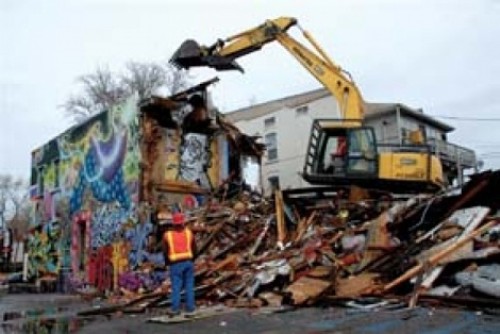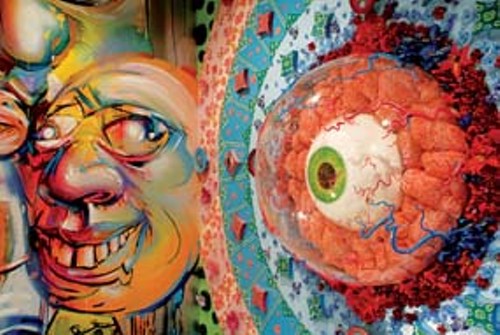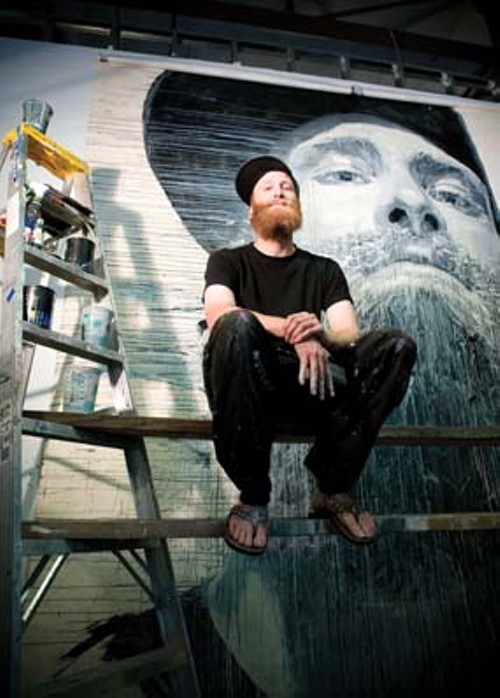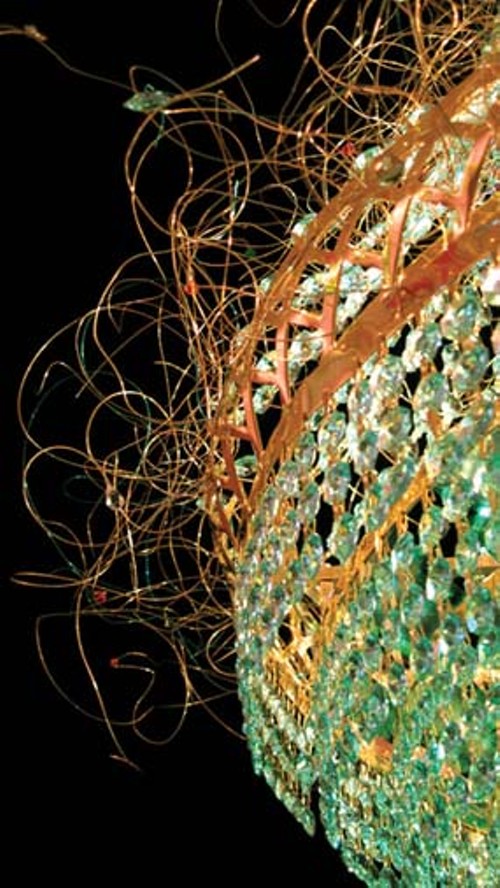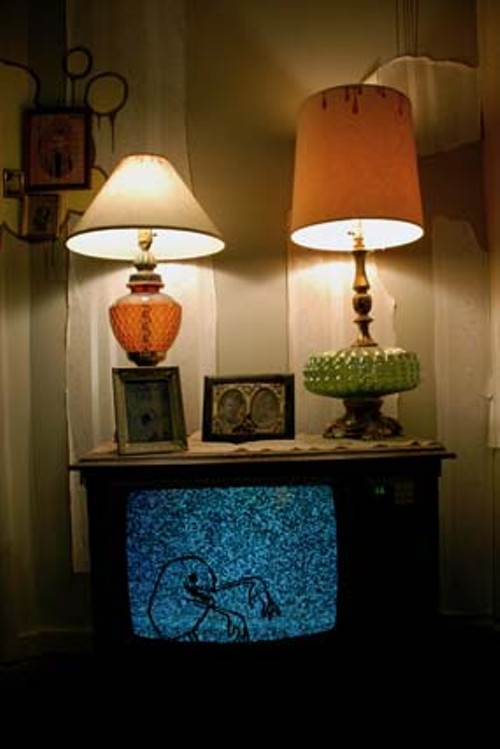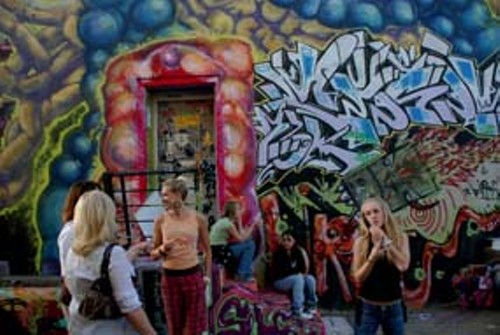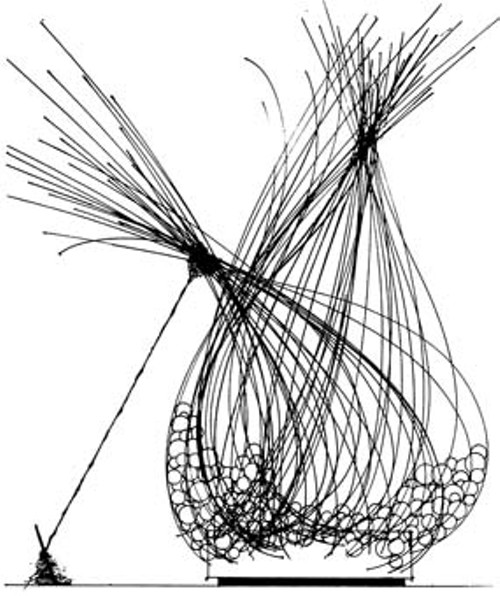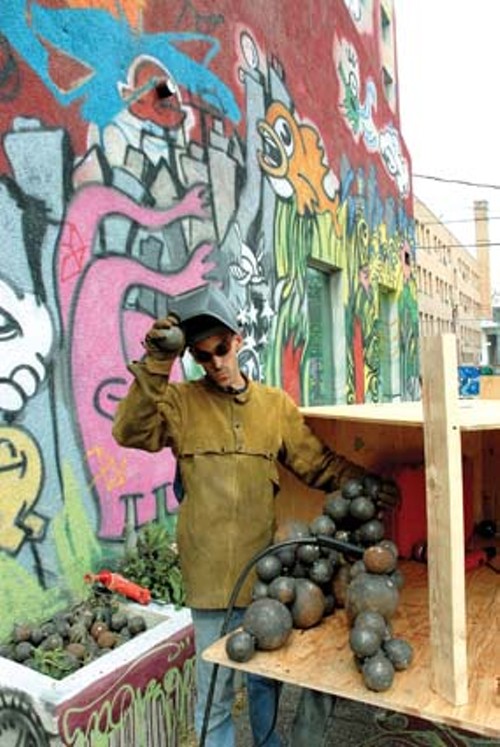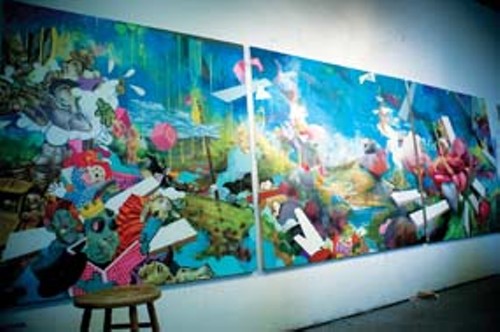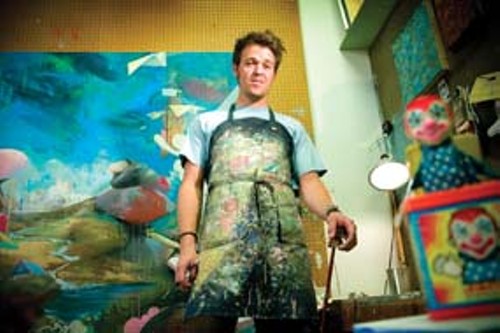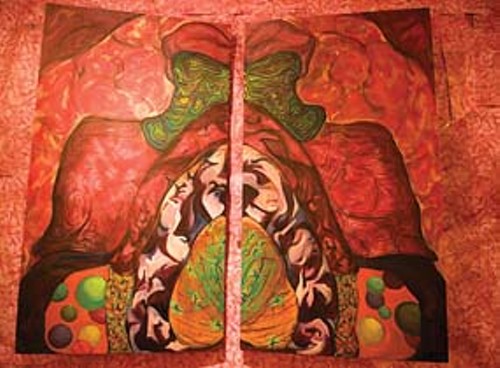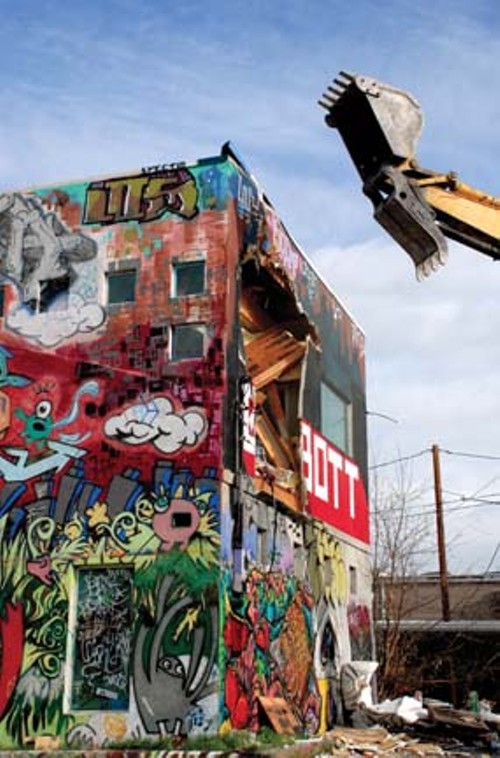No one protested when 337 tumbled to the ground on April 5, 2008, and later in the Fort Douglas Post Theatre, no one outwardly cringed as archived footage revealed a giant bulldozer gnawing on 337 again and again, its steel teeth chewing up fragments of the two-story building in downtown Salt Lake City and spitting them out like chunks of colorful cake. No one screamed it outright, but the collective hoots and hollers spoke volumes: “Burn, baby, burn!”
Casual observers still may not understand why anyone involved in 337 could enjoy watching its demise. The building united not only professional and amateur artists, but art lovers from all over who turned out in droves to get a piece of the action. Their hunger: insatiable—a strong indicator that, given the right circumstances, Salt Lake City would respond to exploratory art.
“There’s clearly a demand out there for certain kinds of artistic experiences that isn’t being met,” says Salt Lake City lawyer Adam Price. Planning to live downtown, he and his wife/artist, Dessi Price, originally purchased the 19th century bungalow-turned-Plain Jane office space on 337 S. 400 East. Upon learning the building was structurally unsound and should come down, they invited local artists to participate in an experimental endeavor loosely modeled after New York City’s 11 Spring Street—a legendary destination for graffiti artists who had their way with it in 2004 before a developer swept in and transformed the five-story New York landmark into high-end condos.
Back at home, 10,000 people walked through 337 during its three-day run; many more were turned away at the door. Media outlets, including City Weekly, went nuts with coverage—even television news that rarely, if ever, graces downtown gallery strolls showed up, cameras blazing. The curious drove in from Tooele, Park City, Ogden, Provo—you name it—to see what all of the fuss was about. Filmmakers Davis and Haworth recall a kid who rode his BMX bike from West Valley City—not the easiest trek, to be sure. As artist Ben Wiemeyer commented weeks after the documentary screening, “If it’s good enough, they will come.”
“Good enough,” however, is an understatement. Artists in the film frequently toss out terms like “elation,” “freedom,” and “complete joy,” when reflecting upon the 337 experience. Where else, they ask, are you given a space and told to just run with it?
Artists selected to participate in Present Tense: A Post-337 Project, which opens June 20 at the Salt Lake Art Center, definitely weren’t encouraged to “just run with it.” Unlike the original project, this juried exhibition provided rigid guidelines for the more than 75 applicants, 25 of whom were selected based on how successfully their submissions reflected a critical examination of the change in space, how well they played off each other and how effectively they tied together two seemingly disparate platforms. Some artists considered the application process to be “restrictive,” while others accepted the guidelines as perfectly reasonable and affording them the chance to show their work in the prestigious art center which typically features exhibits of national and international acclaim.
The contrast between 337 and Present Tense provides an opportunity for Salt Lake City to revisit the age-old question: “What is art?” And, perhaps more importantly, “Why should we care?"
It might seem like a lot of esoteric nonsense, but consider the implications: certainly, we call it “art” when it’s framed and hanging in a gallery or museum. But art comes alive when it’s splattered across cinderblock—or on a set of garage doors on the west side. Adam Price, who recently incorporated 337 as a nonprofit and now sits on the Salt Lake Art Center’s board of directors, sees the whole community as a canvas. He and other art enthusiasts are collaborating on projects to bridge historically wide gaps: east side, west side; fine art, urban art; class divides; tension between artists and the institutions that show their work. If everyone could come together, the collective force might help convince the public to buy into this thing they call art.
Salt Lake Art Center and a mission
This talk of unity is fine, but who will lead the charge to unify, and will they encounter resistance? Skeptics fear the worst. A widespread communication breakdown has the artistic community in isolated groups operating in oddly parallel universes. Artists spar with one another, with institutions and patrons. Their frustrations stem partly from the way the scene is set up:n
Commercial galleries tend to favor “traditional” artworks—landscapes, portraits, Western-themed jewelry … nothing too shocking. Because ... they sell. Up-and-coming or experimental artists gravitate toward nontraditional venues, from independent music and bookstores, to coffee shops and select galleries or alternative nonprofits recognized for taking risks. Sometimes, artists simply throw their art up on public spaces where the canvas allows for spontaneous, uninhibited—if illegal—creativity.
Ostensibly, the Salt Lake Art Center exists somewhere in the middle of the spectrum. The center is not a commercial gallery. It is not a museum. It is an institution dedicated to showcasing contemporary artwork. For 76 years, its staff has worked valiantly to assert the center’s importance.
“I think the perception of Utah by generally everyone who has not visited Utah is that, ‘You just have Mormons there,’” says Roni Thomas, director of media relations for the center. “You don’t have culture, you don’t have music, you don’t have film, you don’t have mountains, you don’t have skiing—you have Mormons!’ People are so close-minded about things. I just shrug it off and say, ‘Well, it’s your loss.’"
Thomas adds that she’d never assume any other town outside of New York City or San Francisco is, by default, less interesting or less cosmopolitan. Besides, she says, people who have visited the center are beginning to spread the word about recent exhibitions, including last summer’s Life After Death: New Leipzig Paintings From the Rubell Family Collection. “We had a piece here by Neo Rauch that hadn’t been shown anywhere in the world—in the world! That’s pretty impressive.”
Beyond typical out-of-state naysayers, the center contends with longstanding obstacles in its own back yard.
“Contemporary art in Salt Lake City as a whole is not as well accepted or recognized as an art form that people want to get involved with,” Thomas says. “The culture is more attuned to the performing arts than it is to visual arts, across the board—not just contemporary, but contemporary takes another turn. It’s something that people aren’t as comfortable with because they look at it and say, ‘Well, I don’t get it. It makes me uncomfortable. It makes me have to think about something,’ and sometimes people don’t want to do that.”
Thomas acknowledges Salt Lake City has changed quite a bit since 1931, significantly so after the 2002 Olympic Winter Games gave the town a much-needed ego boost.
The Salt Lake Art Center has also changed, most recently with the October departure of director Ric Collier. His replacement, Heather Ferrell, takes over in mid-July. Collier was instrumental in the center’s signing on with 337 and, with Adam Price, helping conceptualize Present Tense while the original project was still in progress.
By many artists’ accounts, 337 was the first time in recent memory the center went out of its way to connect with them.
“I think stagnation is the perfect word for it. I think they didn’t know how to overcome it,” says Trent Thursby Alvey, a prominent Utah artist whose sculptural work is among the Utah Museum of Fine Arts’ permanent collection. Her piece in the original 337 tackled Utah’s history of nuclear testing and helped inspire the multimedia art installation, Exposed.
Alvey believes 337 highlighted certain fundamental flaws in the system. “Everyone knew there were things broken with the community. I don’t know if you recognize them as being broken when you’re in it, but after, you go, ‘Wow, that was really screwed up.’ I just don’t think the artists felt they were welcome.”
Alvey considers Present Tense a perfect opportunity for the center to re-examine its priorities. “They need to figure out how to access people, how to get people into the space,” she says. “With the show, it will bring in a whole bunch of people who haven’t been there in a while. It will be a whole, fresh kind of work that artists can relate to. And since they’re bringing their 337 experience with them, they’ll already be open-minded about what they’re going into, whereas before it was, ‘Maybe I shouldn’t go in there because it’s too esoteric. Maybe we don’t understand the artwork in there.’”
Collier left the center after 11 years at the helm to resume an art-making career that had collected dust for three decades. He says the visual-art community was broken long before he took over:
“I came into a situation that was pretty bankrupt—I believed at the time I arrived the center didn’t like artists, it didn’t like community, it didn’t like a lot of things. Today, I don’t think it’s quite like that.”
Collier got involved with 337 because he believed it could help unite indifferent factions of the artistic community.
“I remember sitting down with two artists who I really valued and asked why they wouldn’t come to an opening at the art center,” he says. “They told me, ‘We know this group might be there, and we don’t want to run into them.’” Collier was floored. How could they squander an opportunity to network? Hadn’t they ever heard of strength in numbers?
With 337, “I wasn’t concerned about its aesthetic merit as much in terms of it coalescing a lot of disparate groups,” he says, adding that people and institutions like Adam Price, Art Access, The Pickle Company and Kayo Gallery are critical to providing common ground for individual artists. The Salt Lake Art Center can’t do it all on its own.
“I think there is a lot of work to be done in this community; I think that it will continue to be if not a struggle, at least a good fight,” he says.
Ben Wiemeyer, who participated in 337 and who will show in Present Tense, has worked as proprietor—ordering, shipping, hanging, lighting, dismantling exhibitions, etc.—at the Salt Lake Art Center for three years. As a member of Salt Lake City’s “underground” or “nontraditional” network of artists (he’s not a fixture at mainstream galleries) and one of nine employees at the center, he enjoys rare insight on both sides of the issue.
“I think it’s a miscommunication and a misinterpretation of intentions,” he says, adding that people who complain to him aren’t just upset with status quo—some are downright bewildered. “A lot of my friends don’t even know about the art center. They don’t know where it is or what it is. That’s frustrating for me.” (FYI: the Salt Lake Art Center is located on 20 S. West Temple, adjacent to the Salt Palace Convention Center.)
Roni Thomas and Jay Hueman, curator of exhibitions, are also frustrated. They’re not sure when the center suddenly became the big, bad wolf.
“I think we are viewed as the establishment a lot of times by people, which is—well, I don’t understand that,” Thomas says. She believes Present Tense will start to open artists’ eyes to the center, its mission, the hours staff members keep and how they’re really on—or at least very near—the same page. “Typically, there are four of us on any installation who do everything, and now we’re inviting 25 artists into our house to do what they do, so it’s going to be really interesting.”
Wiemeyer is counting on equal effort from the community and artists. “If people are frustrated in the community and they’re frustrated as artists, they need to communicate that. If you’re frustrated, don’t just go running your mouth to your homey—e-mail us. Tell us. Do it anonymously,” he says, laughing and shaking his head. “Just send a letter.”
And if the floodgates open, the center had better be ready to do its part.
“As studio artists, we produce these things, we set them down and we critique them. You might not like what anybody has to say about it, and it might hurt your feelings, but you’re going to go home, sit and digest, and come back that much stronger,” Wiemeyer says. “I think we really need that open communication at the Salt Lake Art Center. As an institution, we need to be able to take that critique and digest it and say, ‘Hey, maybe this isn’t working.’”
Present Tense under pressure
It seems everyone is banking on Present Tense to usher in the shake-up.n
The exhibition is a nice slice of who’s who in local contemporary art (see box, p. 27). Each artist has created stunning works that range from Alvey’s scientific exploration of emergent phenomenon, with Mason and Ball jars filled with found objects and stacked in an orderly fashion, to Wiemeyer’s 20-foot self-portrait in which he looks like Rasputin, affixed with mechanized shredder designed to eat away three inches of the painting every day until the show ends Sept. 27.
Other highlights: Amy Caron and Margaret Willis are reprising a section of their collaborative piece, “Waves of Mu,” a wall-to-floor installation based on neuroanatomy—essentially a “walkable brain”—using diptych oil paint, digital photo print posters and two large chandeliers. Dessi Price builds on the Buddhist themes explored in her 337 piece, depicting a multitasking woman in meditative space, with "American Mandala," made entirely of fast-food logos to convey “the misfortune we bring to ourselves by eating fast food,” as well as to comment on the hypnotic effect of modern advertising and subliminal messages on American psyches. CJ Lester, who worked on 337’s text-heavy main-level bathroom installation, continues her focus as a social commentary artist with “Zaftig Dolls,” three 6-feet-tall “paper doll” silhouettes covered in text reflecting their thoughts and dialogues with one another. At press time, Forbes was still struggling with how to create an illusion of false rocks disturbing the gallery space and “attempting to re-create the awe of an outside project.”
Dave Doman, who “had a few things lurking around the 337 building,” including the striking ’20s-flapper girl with the word “love” in red dimensional-style lettering, distanced himself a bit from his usual art-making process. He created a flower garden of Masonite 2-by-4s and miscellaneous scrap wood, with painted flowers placed on different levels to create a level of depth. “My favorite street texture is the cinderblock wall,” he says. “So I decided to try and bring that feeling into the gallery.”
“The public response made me realize that people do pay more attention to art in Salt Lake, so in that aspect, it definitely inspired me to feel good about making things,” Doman says of 337.
Some artists took issue with Present Tense’s supposedly exclusionary nature—believing that the submission process was somehow unfair and biased. To counter that perception, curator Jay Hueman worked to ensure he had no part in the curatorial process, instead handing it off to Brigham Young University Museum of Art director Campbell Gray. A thoughtful, articulate Australian expatriate, Gray emigrated from Sydney to the United States 11 and a half years ago.
“I suspected at some point as curator of education I was going to be developing programming for it, and obviously I ended up inheriting a very different role in relation to the project as a whole,” Hueman says of his current position. “I didn’t want to conceive of educational programming that necessarily favored artists that I knew.”
Gray was only vaguely aware of the 337 building when he received a phone call from Hueman offering him a guest curator position for Present Tense. “He had a certain amount of aesthetic distance from 337. He wasn’t involved with the project; he’s not really that familiar with the artists’ personalities,” Hueman says. The distance, he says, allowed Gray to objectively consider Present Tense submissions in regard to contemporary art in Utah, nationally and globally, and to make a qualified selection that best reflected a cross-section of the 337 building.
Thomas adds, “Of course, there are always people who aren’t happy they weren’t chosen.”
Gray walked into his guest curator position with an open and optimistic mind. Though he was, “a little suspicious of the quality of work before I saw 337,” his visit to the building erased any doubts he might have had about submissions to Present Tense. The whole experience “has been a real eye-opener to the practice of contemporary art in Salt Lake City,” he says. “It’s broader and much more vibrant than what I thought it was.”
Welcome to our art and neighborhood
If Gray, who makes his living studying contemporary art, underestimated the local talent, imagine what the average resident thinks about it. “When you’re working two jobs, when are you going to squeeze in a gallery stroll?” says Jacob Brace, executive director of Neighborhood House. A Salt Lake City nonprofit, Neighborhood House provides affordable day care and support services to children and adults, based on their ability to pay. Brace says Neighborhood House clients are interested in art, but typically lack the time, inclination and energy to pursue it.n
“Salt Lake City is a small community. There are a lot of artists here, but they’re just not that easily tapped into unless you’re within that culture,” Brace says, adding that he’s definitely not in the loop. A planned collaboration with 337, now an official nonprofit, should change that. Neighborhood House board members contacted 337’s Price and proposed a show featuring commissioned works by urban artists. Those selected will paint a series of eight garage doors attached to Neighborhood House and facing the street on 1050 W. 500 South. “From the artists’ perspective, it’s a chance to get some paying work and it’s going to be juried, so hopefully it’s something they can put on their resumes,” Price says. “It’s also going to get art into, essentially, an artistically underserved community.”
“One of the things 337 brings is an audience that’s not afraid of the west side,” Brace says. “It’s not your traditional gallery stroll audience. So they’re probably going to be coming over without even thinking about where they are. It’s not going to be a trip where they call up their friends and say, ‘Let’s go to the west side,’ it’s going to be, ‘Let’s go to over to Neighborhood House and check out 337’s project.’"
As our city grows, so do our options for viewing and creating art. Neighborhood House hopes to enrich its clients’ lives and increase its profile through visual art projects. While the organization has been around for 114 years, many don’t know what or where it is—which sounds a bit like the Salt Lake Art Center.
“If we can somehow get out of our comfort zone and stop pigeon-holing ourselves, maybe we can help these artists get out as well,” Brace says. It would be cool if we had an artist five years from now who said, ‘Oh yeah, I know Neighborhood House—I did one of my first major projects there and somebody saw it and I got commissioned to do a piece somewhere else.’ Neighborhood House could help launch careers—that message to our kids is invaluable.”
Brace wants to see downtown gallery strolls extend under or over the Interstate 15 viaduct, bringing art to the west side on a monthly basis. He believes it’s possible to bridge gaps between classes and cultures in Salt Lake City, and community-based art is the perfect tool to do it. “Embrace, educate and empower: Once you harness that skill in the community you have something people can rally around.”
Adam and Dessi Price will keep doing their part through additional 337 projects—including a potential collaboration with Liberty Heights Fresh market 1300 South and 1100 East. Their plans involve the market’s dilapidated property across the street (currently a parking lot) that once housed a Dairy Queen. Eventually, a truck will travel around town with revolving installations on display, stopping at yet-to-be-determined locations. And there there are City Center Lofts, a new mixed-use development built with recycled shipping containers on 337 S. 400 East.
In turn, Adam Price hopes Salt Lake City will rally around Present Tense—and that the Salt Lake Art Center will play an integral role in shaking things up.
“There is a legitimate debate about how much the art center should be showing local artists, but I think even when they show international artists they can do a much better job of making clear to artists, ‘We’re doing this partly for you, giving you a chance to get exposed to stuff you can’t see anywhere else in Salt Lake City,’“ Price says. One option, he says, would be to reserve opening nights for local artists. “All of that should be on the table, and I think it will be.”
Which isn’t meant to downplay the public’s role. “A lot of our focus is on education about our exhibitions,” the center’s Thomas says. “With Present Tense, there will be art talks related to the exhibit so there can be a whole conversation about why we’re doing this thing.
“From the time we wake up to the time we go to sleep we are looking at art," Hueman says. "Some of that art is going to be looked at in 20 years with a sense of nostalgia and some of it is going to be looked at in 500 years as incredibly historically significant.”
n
EXHIBITING ARTISTS: n
337 photos by Lewis Francis also on display. For a complete list of artist panels and art talks, visit SLArtCenter.org n
n
DOCUMENTARY: n n
n
PRESENT TENSE: A POST 337 PROJECT
Salt Lake Art Center, 20 S. West Temple, 328-4201, June 20-Sept. 27, 2008
On opening night (Friday, June 20, 6-9 p.m.) Free shuttle bus departs Nobrow Coffee & Tea (315 S. 300 East) every 10 minutes to Salt Lake Art Centern
Trent Alvey, Hairy Baldwin (aka STRUT), Trent Call, Andrew Callis, Amy Caron, Craig Cleveland, Kier Defstar, Cara Despain, Dave Doman, Trinity Forbes, Lenka Konopasek, CJ Lester, William Lewis, Tessa Lindsey, Michael McGlothlen, Shawn Porter, Erin & Nick Potter, William Robbins (aka Elmer Presslee), Dessi Price, Shawn Rossiter, Zara Dawn Shallbetter, Sri Whipple, Ben Wiemeyer, Margaret Willis n
Afterimage: The Art of 337, Filmed by The Dada Factory (Davey Davis & Alex Haworth)
Screenings at Salt Lake Art Center: June 21, July 19, Aug. 16, Sept. 20: 4 p.m.
July 11, Aug. 8, Sept, 12: 7:30 p.m. n
More by Jamie Gadette
-
The Moths
Salt Lake City's The Moths breathe life into Necromancy
- Apr 22, 2015
-
Best of Utah 2014 Photo Booth: Photo Collective (part 3)
- May 13, 2014
-
Best of Utah 2014 Photo Booth: Photo Collective (part 2)
- May 13, 2014
- More »
Latest in Cover Story
Readers also liked…
-
Forget the family pedigree—Robert F. Kennedy Jr should not be the next president of the United States
Trojan Horse
- Jun 21, 2023
-
Women decry harassment and toxic culture at St. George auto dealership
Men at Work
- Oct 11, 2023


